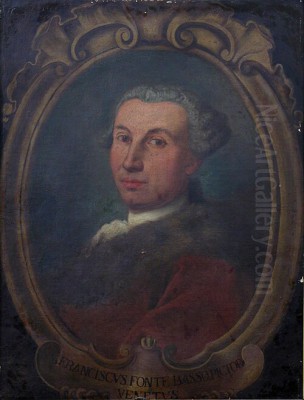
Francesco Fontebasso stands as a significant figure in the vibrant artistic landscape of eighteenth-century Venice. Born in the lagoon city in 1707 and passing away there in 1769, his life spanned a period often referred to as the Venetian Settecento, a final, brilliant flourishing of the Republic's artistic genius before its eventual decline. Fontebasso was a prolific painter and etcher, primarily known for his large-scale decorative frescoes, compelling religious narratives, and historical scenes. His work embodies the transition from the grandeur of the Late Baroque to the lighter, more elegant sensibilities of the Rococo, positioning him as an important, albeit sometimes overlooked, master of his time. While occasionally overshadowed by the towering reputation of his contemporary, Giovanni Battista Tiepolo, Fontebasso developed a distinct and accomplished style, earning prestigious commissions both within Venice and internationally.
Early Life and Artistic Formation
Francesco Fontebasso entered the world in Venice, a city already steeped in centuries of artistic innovation. The precise year of his birth is generally accepted by most art historians as 1707, although a minority of sources suggest 1709. Regardless, his artistic journey began under the tutelage of Sebastiano Ricci (1659-1734). Ricci was himself a pivotal figure, instrumental in revitalizing Venetian painting in the early 18th century after a period perceived by some as less innovative. Ricci's style, characterized by bright colours, dynamic compositions, and a fluid brushstroke, looked back to the High Renaissance master Paolo Veronese while embracing the energy of the Baroque. This training provided Fontebasso with a solid foundation in the Venetian tradition of rich colour and grand scale.
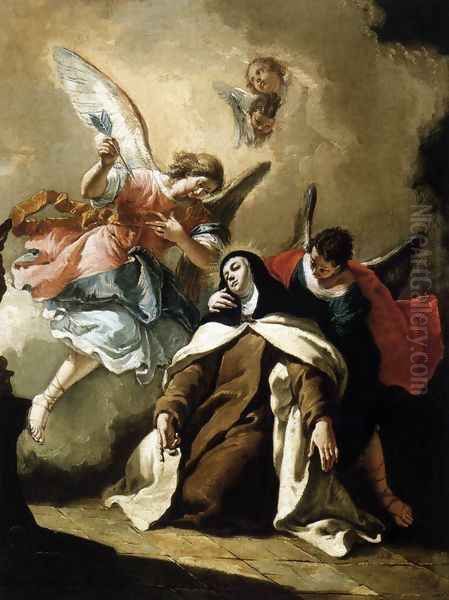
Seeking broader horizons and deeper knowledge, Fontebasso, like many aspiring artists of his era, undertook travels to further his education. Journeys to Rome and Bologna in the late 1720s or early 1730s were crucial formative experiences. In Rome, he would have encountered the monumental works of High Baroque masters such as Pietro da Cortona and Andrea Pozzo, as well as the enduring legacy of the Bolognese school, particularly the Carracci family (Annibale, Agostino, and Ludovico Carracci) and their followers like Guido Reni and Domenichino. These exposures broadened his understanding of composition, draughtsmanship, and the powerful emotional potential of religious and historical painting.
The Pervasive Influence of Tiepolo
While Sebastiano Ricci provided Fontebasso's initial training, the dominant artistic force in mid-18th century Venice, and indeed much of Europe, was Giovanni Battista Tiepolo (1696-1770). It was almost impossible for any Venetian painter of historical or decorative subjects during this period not to engage with Tiepolo's revolutionary style. Fontebasso was no exception; Tiepolo's influence is readily apparent in much of his mature work. Tiepolo perfected a style characterized by luminous, airy compositions, a palette favouring pastel shades alongside vibrant highlights, and an unparalleled ability to depict vast, light-filled spaces, particularly on ceilings.
Fontebasso absorbed key elements of Tiepolo's approach. He adopted a lighter palette than might be typical of the earlier Baroque, employed dynamic, often diagonal, compositional structures, and demonstrated a similar flair for depicting sumptuous fabrics and dramatic gestures. However, Fontebasso often retained a certain solidity and a slightly more contained energy compared to Tiepolo's boundless effervescence. His figures can sometimes feel more grounded, and his colour harmonies, while bright, might incorporate deeper tones, perhaps reflecting his earlier training with Ricci. He successfully synthesized these influences into a personal style that was both elegant and dramatically effective, well-suited to the decorative demands of the era.
Mature Style, Techniques, and Themes
Fontebasso's mature artistic style represents a skillful blend of Late Baroque theatricality and Rococo grace. He excelled in creating large-scale works, particularly frescoes for church ceilings and palace walls, where his compositional abilities shone. He understood how to manage complex multi-figure scenes, often employing foreshortening (sotto in sù) to create convincing illusions of figures ascending into heavenly realms or inhabiting grand architectural spaces. His brushwork was typically fluid and confident, defining forms with energy while also capturing delicate details, especially in fabrics and ornamentation.
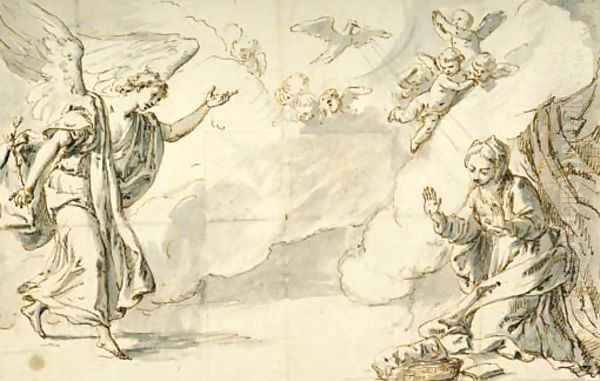
His use of colour was vibrant and varied, contributing significantly to the emotional impact and decorative richness of his paintings. Light plays a crucial role in his work, used not only to model form but also to create atmosphere and highlight key narrative moments. Like Tiepolo, he often bathed his scenes in a bright, clear light, enhancing the overall sense of openness and splendour characteristic of the Venetian Rococo.
Fontebasso was proficient in various media. While best known for his frescoes (painting on wet plaster, buon fresco, often finished with details on dry plaster, a secco), he was also a prolific painter in oils on canvas. These included large altarpieces, smaller devotional works, and historical or mythological scenes. Furthermore, he was an accomplished etcher, producing numerous prints that often explored similar themes to his paintings but allowed for wider dissemination and perhaps a more personal graphic expression. The practice of creating preparatory oil sketches, or bozzetti, was common, and many such lively studies by Fontebasso survive, offering insight into his creative process.
The subject matter of Fontebasso's art was typical of his time, dominated by religious narratives drawn from the Bible and the lives of saints, as well as mythological and historical episodes often carrying allegorical meanings. Works like The Ecstasy of St. Therese and The Martyrdom of St. Catherine showcase his ability to convey intense spiritual experiences and dramatic martyrdoms with both pathos and decorative elegance. The Mystical Marriage of St. Catherine and St. Therese is another prime example of his capacity for depicting tender religious sentiment within a visually rich composition.
Major Commissions in Venice and the Veneto
Fontebasso secured numerous significant commissions throughout his career, decorating some important ecclesiastical and secular buildings in Venice and the surrounding region (the Veneto). An early notable project was the ceiling fresco decoration for the Jesuit Church (Santa Maria Assunta detta I Gesuiti) in Venice, completed around 1734. This work helped establish his reputation as a capable large-scale decorator.
In 1736, he undertook fresco work in the Church of the Annunziata in Trento, although these works were unfortunately later destroyed. His activity extended to decorating palaces for Venetian nobility. Between 1743 and 1752, he worked on frescoes in the Palazzo Duodo. Around 1745, he received a prestigious commission from the Barbarigo family, one of Venice's prominent patrician clans, to decorate their palace, the Palazzo Barbarigo. These palace decorations often involved complex allegorical or mythological schemes designed to celebrate the family's status and virtues.
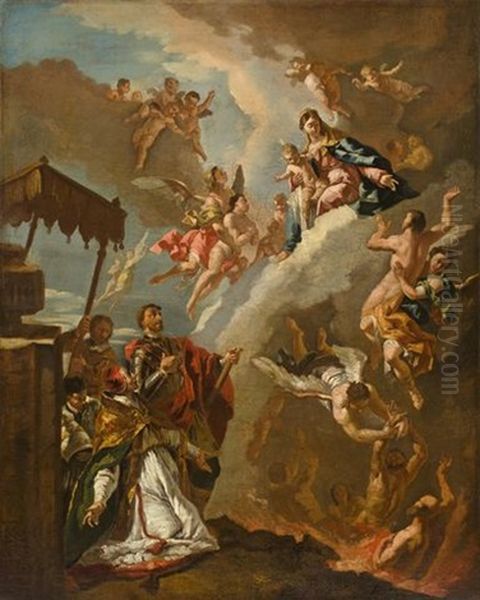
Further afield in the Veneto, he painted frescoes, including a Glory of Paradise, for the church of Santa Maria di Colleollato in Montebelluna. He also contributed decorations to the church of San Francesco della Vigna in Venice, a significant Franciscan establishment. Another project took him back to Trento, where he executed frescoes in the Castello del Buonconsiglio, a major historical site that had seen contributions from various artists over the centuries. These commissions demonstrate his high standing and the demand for his decorative skills among both religious orders and the aristocracy.
Religious and Mythological Narratives
Religious themes formed the core of much of Fontebasso's output, reflecting the continued importance of the Church as a major patron of the arts in Venice. His depictions often focused on moments of intense emotion, divine revelation, or saintly sacrifice, aligning with the dramatic tendencies of the Baroque while incorporating the lighter touch of the Rococo. His Ecstasy of St. Therese, for instance, tackles a subject famously treated by Gian Lorenzo Bernini in sculpture, translating the saint's overwhelming spiritual rapture into a painterly language of dynamic movement and expressive figures.
Similarly, The Martyrdom of St. Catherine presents a scene of violence and faith with a characteristic blend of drama and grace. The composition likely employed diagonals and swirling movement to heighten the tension, while the rendering of figures and drapery would have added to the visual richness. The Mystical Marriage of St. Catherine (often depicted with the Christ Child presenting a ring to the saint) offered scope for portraying divine tenderness and courtly elegance, themes well-suited to Fontebasso's style.
Other documented religious works include an Annunciation, noted for its vibrant colour contrasts and dynamic composition likely influenced by Tiepolo, and a Sacrifice of St. Iphigenia (sometimes possibly misidentified as 'St. Ignazia' in sources), drawing on classical legend often interpreted through a Christian lens. He also painted more general themes like the Madonna and Saints. These works underscore his versatility within religious iconography, adapting his style to suit subjects ranging from intimate devotion to grand celestial visions and dramatic martyrdoms. His mythological paintings, often created for palace decorations, drew on classical sources like Ovid's Metamorphoses, providing opportunities for depicting idealized figures, complex allegories, and scenes of divine power or pastoral beauty.
The Call to St. Petersburg
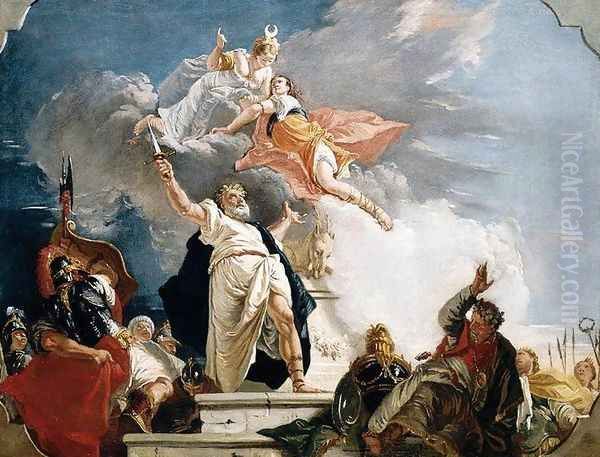
A significant chapter in Fontebasso's career involved an international commission that took him far from Venice. In 1761, he received an invitation from Empress Catherine the Great of Russia to work in St. Petersburg. This was a period when the Russian court actively sought leading European artists, architects, and craftsmen to contribute to the grandeur of the rapidly developing imperial capital, a policy initiated by Peter the Great and enthusiastically continued by Catherine.
Fontebasso spent almost two years in Russia, from 1761 to 1762. His primary task was to execute ceiling paintings and other decorations for the Winter Palace, the opulent official residence of the Tsars, and potentially other imperial residences. This commission placed him in the company of other foreign artists working for the court and represented a major acknowledgment of his status. Beyond large-scale decorations, his time in Russia likely involved painting easel pictures, possibly including portraits or genre scenes, for the imperial collection or associated patrons.
Furthermore, his role extended to teaching; he served as a professor at the Imperial Academy of Arts in St. Petersburg, contributing to the development of artistic education in Russia based on Western European models. This Russian sojourn not only added an international dimension to Fontebasso's career but also played a part in the transmission of the Venetian decorative style to the Russian Empire, influencing local artists and contributing to the cosmopolitan artistic environment fostered by Catherine the Great. Other Italian artists, like Francesco Bartolomeo Rastrelli (architect) and Pietro Rotari (painter), were also key figures in shaping the look of imperial Russia during this era.
Later Career and the Venetian Academy
Upon his return to Venice around 1762, Fontebasso resumed his active career in his native city. He continued to receive commissions and remained a respected figure in the local art world. His involvement with the official structures of Venetian art became more formalized during this later period. He was among the founding members of the Venetian Academy of Painting and Sculpture (Accademia di Belle Arti di Venezia) when it was formally established or reorganized in 1755/56, an institution aimed at promoting artistic excellence and providing structured training.
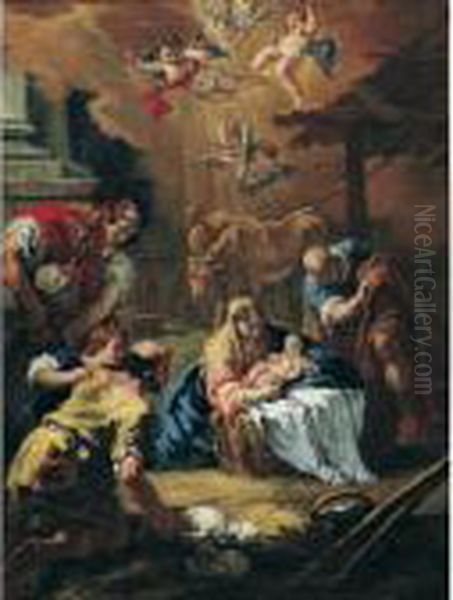
His standing within the Academy grew, culminating in his election as its President (Principe) in 1768. This prestigious position reflected the high esteem in which he was held by his peers. It was a role often occupied by the city's leading artists; for instance, Giovanni Battista Tiepolo had also held the position earlier. Serving as President involved administrative duties and represented the pinnacle of official recognition within the Venetian artistic community. However, his tenure was brief. Francesco Fontebasso passed away in Venice on May 31, 1769, the year after assuming the presidency, bringing a long and productive career to a close.
Fontebasso and His Contemporaries
Francesco Fontebasso operated within one of the most dynamic artistic environments in 18th-century Europe. His relationship with his teacher, Sebastiano Ricci, and the dominant figure of Giovanni Battista Tiepolo has already been noted as fundamental to his development. But Venice teemed with other talented artists, creating a milieu of influence, collaboration, and sometimes competition. Giambattista Piazzetta (1683-1754) was another major figure painter, known for a more tenebrous, earthy style compared to Tiepolo's luminosity, though Tiepolo himself showed Piazzetta's influence early on.
In the realm of decorative painting, Fontebasso's contemporaries included figures like Giovanni Antonio Pellegrini (1675-1741), Ricci's brother-in-law, who also enjoyed an international career, and Jacopo Amigoni (1682-1752), another exponent of the Rococo style who worked extensively abroad. Giambattista Pittoni (1687-1767) was a rival history painter known for his elegant, often emotionally charged religious and mythological scenes. Gaspar Diziani (1689-1767) was another prolific fresco painter, sometimes collaborating with Tiepolo. Even Tiepolo's own son, Giovanni Domenico Tiepolo (1727-1804), became a notable painter in his own right, initially assisting his father and later developing a distinct style, particularly in genre scenes and drawings.
Beyond history and decorative painting, Venice was famed for its vedutisti, or view painters. Giovanni Antonio Canal, known as Canaletto (1697-1768), brought topographical painting to new heights of precision and atmospheric effect, primarily catering to the Grand Tour market. Francesco Guardi (1712-1793), whose sister married Tiepolo, developed a looser, more atmospheric style of view painting, capturing the fleeting moods of the city. Rosalba Carriera (1675-1757) achieved international fame for her exquisite pastel portraits, while Pietro Longhi (1701-1785) specialized in intimate genre scenes depicting the daily life and social rituals of the Venetian aristocracy and bourgeoisie. Fontebasso also collaborated with sculptors like Giovanni Maria Morlaiter (1699-1781) on integrated decorative schemes. This rich tapestry of talent formed the backdrop against which Fontebasso forged his successful career.
Lesser-Known Aspects: Etchings and Drawings
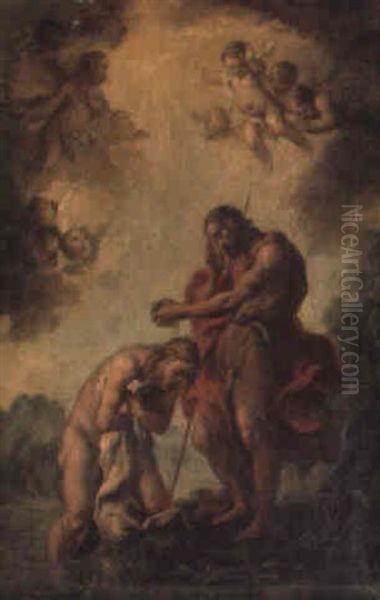
While Francesco Fontebasso is primarily celebrated for his paintings and frescoes, his activity as an etcher and draughtsman constitutes an important, though perhaps less widely known, facet of his oeuvre. He produced a considerable number of etchings, demonstrating a high level of technical skill in this medium. His prints often explored themes similar to those found in his paintings – religious subjects, mythological narratives, and allegorical scenes. Etching allowed him to reach a wider audience beyond those who could commission or view his large-scale works directly.
His graphic style in etching often displays a lively, fluid line, capturing movement and expression with spontaneity. These prints sometimes reveal a more intimate or experimental approach compared to his formal painted commissions. He also contributed designs for book illustrations, another avenue for his graphic talents that was common among artists of the period.
Furthermore, numerous drawings by Fontebasso survive, executed in various techniques such as pen and ink with wash, or chalk. These drawings include preparatory studies for paintings, compositional sketches exploring different arrangements, and individual figure studies. They offer valuable insights into his working methods, revealing his careful attention to anatomy, drapery, and expression, and showcasing his confident draughtsmanship. Like his etchings, his drawings often possess an immediacy and energy that complements the more finished quality of his paintings, highlighting the foundational role of drawing in his artistic practice. These graphic works underscore Fontebasso's versatility and his engagement with different artistic media beyond large-scale painting.
Legacy and Assessment
Francesco Fontebasso occupies a respected place in the history of 18th-century Venetian art. While perhaps inevitably standing somewhat in the shadow of the exceptionally gifted Giovanni Battista Tiepolo, Fontebasso was nonetheless a highly accomplished, versatile, and prolific artist who made significant contributions to the final flowering of the Venetian school. He successfully navigated the stylistic transition from Late Baroque to Rococo, creating a personal idiom characterized by vibrant colour, dynamic composition, and decorative elegance.
His numerous commissions for churches and palaces in Venice, the Veneto, and notably in St. Petersburg, attest to his contemporary reputation and skill, particularly as a fresco painter capable of handling large and complex decorative schemes. He played a key role in disseminating the Venetian decorative style, both within Italy and abroad, particularly through his work for the Russian court. His involvement with the Venetian Academy, culminating in his presidency, further underscores his standing within the artistic community of his time.
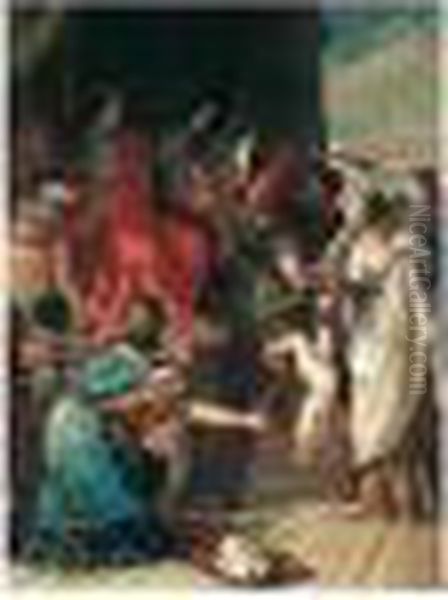
Today, his works can be found in numerous churches and palaces in Venice and the surrounding region, as well as in major museums across Europe and North America, including the Gallerie dell'Accademia in Venice, the Hermitage Museum in St. Petersburg, the Louvre in Paris, and the Metropolitan Museum of Art in New York, among others. While perhaps not possessing the sheer innovative genius of Tiepolo, Francesco Fontebasso remains a crucial figure for understanding the richness and diversity of Venetian painting during the Settecento, an artist whose skill and productivity significantly shaped the visual culture of his era.
Conclusion
Francesco Fontebasso's career exemplifies the vitality and adaptability of the Venetian artistic tradition in its final century of independence. As a student of Ricci and an adept follower of Tiepolo, he synthesized the key stylistic currents of his time into a distinctive and appealing manner. His mastery of large-scale fresco decoration, his sensitive handling of religious and mythological themes, and his prolific output across various media secured him a prominent position in the competitive art world of 18th-century Venice. From the ceilings of Venetian churches and palaces to the imperial halls of St. Petersburg, Fontebasso left an indelible mark, contributing significantly to the enduring legacy of Late Baroque and Rococo art. He remains an important master whose works continue to delight viewers with their colour, energy, and decorative flair.